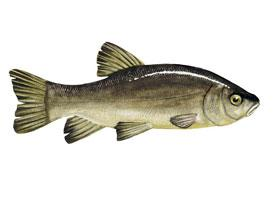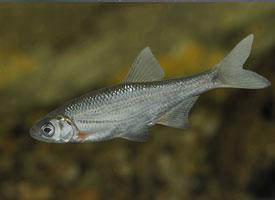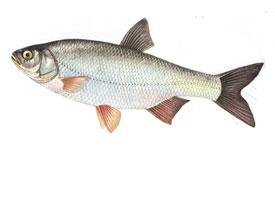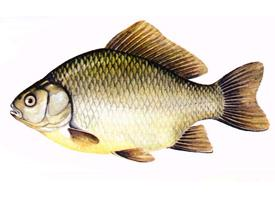
Greutăți și măsuri
| Lungime | 35 55cm |
|---|---|
| Greutate | de la 0,4 la 3 kg |
Descrierea animalului
The Tench (Tinca tinca) is a captivating freshwater fish, belonging to the cyprinid family, which is widespread across Europe and parts of Asia. Known for its distinctive features and behaviors, the tench has intrigued anglers and naturalists alike for centuries. This fish is often found in slow-moving or still waters such as lakes, ponds, and rivers with muddy bottoms where aquatic plants are abundant.Adult tench typically reach a length of about 30 to 70 cm (12 to 28 inches), with a weight ranging from 2 to 4 kg (4.4 to 8.8 lbs), though larger specimens exceeding these sizes have been recorded. They possess a robust, stocky body that is covered in small, fine scales, which feel smooth to the touch. The skin of the tench is notably thick and slimy, providing protection against parasites and injuries. Their coloration is one of their most striking features, with shades ranging from olive-green to almost black on the back, blending to a golden-yellow or even a silvery hue on the belly. This camouflage is perfect for their preferred habitats among dense vegetation.
One of the most distinguishing characteristics of the tench is its tiny, almost inconspicuous eyes, which are set into a broad, rounded head. The mouth is small and positioned at the front of the face, equipped with thick, fleshy lips that are sensitive and used for searching out food in the muddy substrates. The tench has a single dorsal fin, which is short but has a strong, stiff spine at its leading edge, and a rounded anal fin. The pelvic fins are positioned well forward, underneath the body, aiding in its ability to navigate and stabilize itself in the water.
Tench are known for their hardiness and adaptability, thriving in waters that may be low in oxygen where other fish species might struggle. This resilience is partly due to their ability to absorb oxygen through their skin, a unique adaptation among fish. Their diet is omnivorous, consisting mainly of invertebrates, plant material, and detritus. They are bottom feeders, using their sensitive lips to sift through mud and silt to find food.
Reproduction occurs in late spring or early summer when water temperatures rise. Females release thousands of eggs among aquatic plants, which are then fertilized by the males. The sticky eggs adhere to the vegetation until they hatch, about a week later, depending on the temperature. Juvenile tench are vulnerable to predation, but those that survive grow quickly, reaching sexual maturity in two to three years.
The tench is not only of interest to anglers, who prize it for its fighting spirit and the challenge it presents in catching, but also holds a place in folklore and traditional medicine. It was once believed that the slime of the tench had healing properties, particularly for wounds and diseases of other fish.
Despite its widespread distribution, the tench faces threats from habitat loss, pollution, and competition from invasive species. However, it remains a common species in much of its range and is not currently considered endangered. Conservation efforts and responsible fishing practices are essential to ensure the tench continues to thrive in its natural habitats for generations to come.
Animale similare
Fotografii noi cu animale
Top 10 animale
- Dolphin gull (Leucophaeus scoresbii)
- Diana monkey (Cercopithecus diana)
- Moustached guenon (Cercopithecus cephus)
- Galápagos tortoise (Geochelone nigra complex)
- Stone loach (Barbatula barbatula)
- Greek tortoise (Testudo graeca)
- Japanese macaque (Macaca fuscata)
- Russian tortoise (Testudo horsfieldii)
- Common flying dragon (Draco volans)
- Galápagos penguin (Spheniscus mendiculus)


